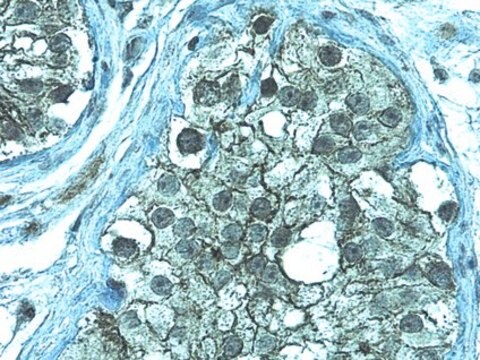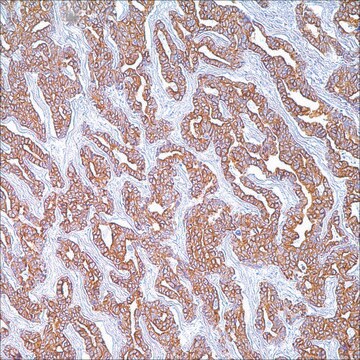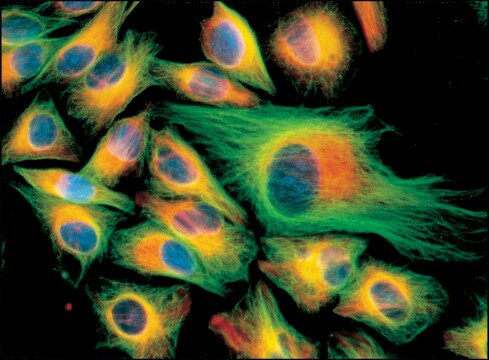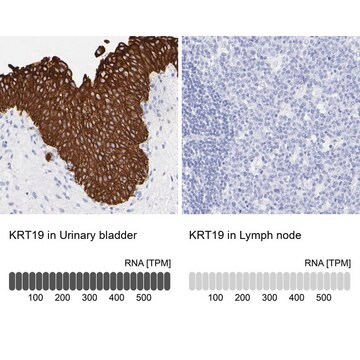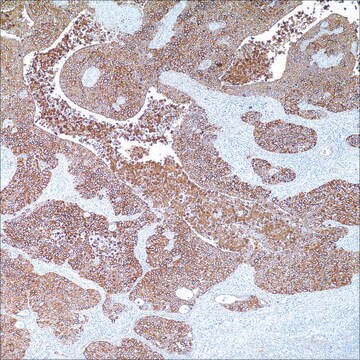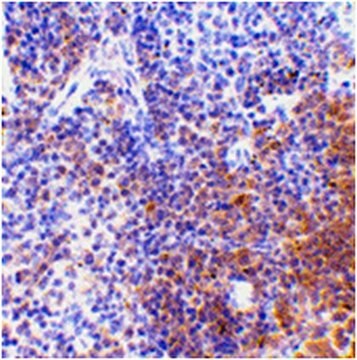MAB3412
Anti-Cytokeratin AE1/AE3 Antibody, recognizes acidic & basic cytokeratins, clone AE1/AE3
clone AE1/AE3, Chemicon®, from mouse
Synonym(s):
Pan cytokeratin
About This Item
Recommended Products
biological source
mouse
Quality Level
antibody form
purified antibody
antibody product type
primary antibodies
clone
AE1/AE3, monoclonal
species reactivity
chicken, mouse, monkey, human, rabbit, bovine, rat
manufacturer/tradename
Chemicon®
technique(s)
ELISA: suitable
immunohistochemistry: suitable
western blot: suitable
isotype
IgG1
shipped in
wet ice
target post-translational modification
unmodified
Gene Information
bovine ... Krt1(100301161)
human ... KRT1(3848)
mouse ... Krt1(16678)
rat ... Krt1(300250)
General description
Specificity
Immunogen
Application
A previous lot of this antibody was used for ELISA (Woodcock-Mitchel & Sun, 1982).
Western blot:
(Woodcock-Mitchel & Sun, 1982; Tseng et al., 1982; Laster et al., 1986) ELISA: (Woodcock-Mictchel & Sun, 1982)
Immunohistochemistry(paraffin):
0.5-2 µg/mL of a previous lot was used on staining of unfixed frozen or formalin -fixed, paraffin-embedded tissue section (Woodcock-Mitchel & Sun, 1982; Tseng et al., 1982; Asch * Asch, 1986; Rodriguez et al., 1986; Clausen et al., 1986; Klein-Szanto et al., 1987; Reibel et al., 1985). Trypsin or pepsin digestion is required for proper staining on paraffin embedded tissues. {Trypsin 1 mg/mL 10 minutes, 37°C, or pepsin 1 mg/mL 5 minutes 37°C}. High temperature with citrate antigen retrieval can also be used.
Optimal dilutions must be determined by end user.
Cell Structure
Cytokeratins
Quality
Western blot:
1:500 dilution of this lot detected CYTOKERATIN AE1/AE3 on 10 μg of A431 lysates.
Target description
Physical form
Storage and Stability
DO NOT FREEZE.
Analysis Note
All epithelium-derived tissues & tumors
Other Notes
Legal Information
Disclaimer
Not finding the right product?
Try our Product Selector Tool.
signalword
Danger
hcodes
Hazard Classifications
Repr. 1B
Storage Class
6.1D - Non-combustible acute toxic Cat.3 / toxic hazardous materials or hazardous materials causing chronic effects
wgk_germany
WGK 1
flash_point_f
Not applicable
flash_point_c
Not applicable
Certificates of Analysis (COA)
Search for Certificates of Analysis (COA) by entering the products Lot/Batch Number. Lot and Batch Numbers can be found on a product’s label following the words ‘Lot’ or ‘Batch’.
Already Own This Product?
Find documentation for the products that you have recently purchased in the Document Library.
Articles
16HBE14o- human bronchial epithelial cells used to model respiratory epithelium for the research of cystic fibrosis, viral pulmonary pathology (SARS-CoV), asthma, COPD, effects of smoking and air pollution. See over 5k publications.
Our team of scientists has experience in all areas of research including Life Science, Material Science, Chemical Synthesis, Chromatography, Analytical and many others.
Contact Technical Service